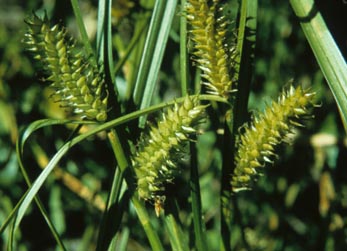Beaked Sedge

Common Name(s):
Beaked Sedge
Bladder sedge
Blue sedge
Scientific Name:
Carex rostrata Stokes
Scientific Name Synonyms:
Carex inflata Huds
Carex utriculata (Boott) Bailey
Carex ambigens Fernald
Carex anticostensis Fernald
Symbol:
CARO6
Description:
Life Span: Perennial
Origin: Native
Season: Cool
Growth Characteristics: Beaked sedge is a large, frost-tolerant, water-obligate, sod-forming sedge. Its stems may be single or grouped together, ranging in height from 12 to 48 inches. It reproduces by seed, band stout, whitish rhizomes 1-9 inches long. It flowers from June to July. Bud generation occurs in August and September and shoots flower the following summer. Rhizomes produce a matted and tufted growth pattern. First a long rhizome emerges and a shoot is produced. Then, short rhizomes develop to produce a tuft of many shoots. Dead shoots with living roots can still establish daughter shoots from rhizomes. When shoots first develop, they do not have roots.
Growth Characteristics: Beaked sedge has a lifespan varying from 2 to 6 years. Shoots that grow in summer live longer than those that grow in spring. Beaked sedge stays green well into fall because of the moist habitat but does turn brown before winter. Many shoots emerge, overwinter, grow through the next season, overwinter, flower, and then die in August.
Seedhead: The spike seadhead is yellowish green in color, turning to reddish purple. It has 2-4 terminal, male spikes, which are 3/8-3 inches long, and up to 1/8 inch wide. There are 2-5 female spikes lower on the seedhead. These spikes are larger, cylindrical and oblong, 3/4-3 1/2 inches long, and up to 1/16 inch wide. The scale on the female spikes is 3-nerved, and its margins are somewhat translucent. The bract enclosing the seed is oval to egg-shaped. It is bladdery, shiny, and yellowish green to straw-colored or reddish at maturity. The beak of the seed has two short teeth. The seed is an achene with blunt angles, and yellowish brown in color.
Leaves: Beaked Sedge has 4-10 flat, waxy leaves, up to 1/2 inch wide, and 8-24 inches long. The Basal leaves have horizontal striations along the leaf and are about as long as the stems.
Stem: The Stems ariseseparately or with few together forming a dense sod; they are bluntly triangular in cross-section below the spikes, spongy, and smooth.
Ecological Adaptions:
Beaked sedge occurs in riparian and wetland habitats including wet meadows marshes, swamps, lake and pond edges from valleys to subalpine and is usually dominant or codominant where is occurs. Beaked sedge grows best on gentle slopes. Beaked sedge grows in areas where water is as far as 32 inches below the soil surface, as well as in areas with standing water as deep as 39 inches. It is often found in climates which are cool and semiarid, with 12 inches of annual precipitation of 12 inches, at elevations from 5,700-10,500 feet.
Beaked sedge is characteristic of early seral, aquatic habitats. It is common in recently formed beaver ponds and on sites with a high water table. Beaked sedge communities have little species diversity, and invasion is limited by the dense rhizome network. Beaked sedge is often succeeded by willows, rushes, and reed grasses.
Soils: Beaked sedge is adapted to a variety of mineral and organic soils. Soil pH tolerance ranges from 3.0 to 7.9. It is not tolerant of alkaline or saline conditions.
Associated Species: Awned sedge, inflated sedge, water sedge, tufted hairgrass, willow, sphagnum moss, fewflowered spikesedge, Kentucky bluegrass, common willow-herb, water horsetail, purple cinquefoil, and timothy.
Uses and Management:
Animal preference for beaked sedge varies seasonally. Beaked sedge provides good forage in the spring but becomes tough during the summer; however, palatability in riparian areas is higher late in the growing season. Elk consume beaked sedge late in the season. Frosts or hard freezes on upper elevation meadows make forage unpalatable in the fall. Beaked sedge is an important component of valuable breeding and feeding grounds for geese and other waterfowl. Birds that are commonly associated with beaked sedge habitats are: mallard, green-winged teal, common yellowthroat, red-winged black bird, song sparrow, and tree swallow. Beaked sedge stands are usually more important as feeding grounds than as nesting grounds because of their low stature, structural diversity, and high water levels. Beaked sedge has a high potential for biomass production and long-term revegetation, and medium potential for erosion control and short-term revegetation. Beaked sedge sod rapidly recolonizes disturbed sites by rhizome expansion. Its rhizomes form a dense network that is effective in stabilizing streambanks and preventing soil erosion. Eskimos eat the lower part of beaked sedge.

